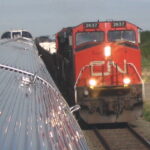Amtrak May Bring Back Several Popular Trains
The new Amtrak authorization bill, passed by Congress and – whaddaya know! – signed by President Bush*, has started folks talking about restoring some old Amtrak routes. Three are actually written into the bill … not a mandate, but directing Amtrak to study the feasibility of bringing back the three trains.
 The first is restoring the Florida portion of the Sunset Limited’s route, shown here arriving in New Orleans after crossing the Mississippi on the Huey Long bridge. Because of severe damage by Hurricane Katrina to the tracks between New Orleans and Orlando, that part of the train’s route was suspended and since the storm, the train has been operating only between Los Angeles and New Orleans. The tracks have long since been moved farther inland and are in operation, but Amtrak still hasn’t restored service to Orlando.
The first is restoring the Florida portion of the Sunset Limited’s route, shown here arriving in New Orleans after crossing the Mississippi on the Huey Long bridge. Because of severe damage by Hurricane Katrina to the tracks between New Orleans and Orlando, that part of the train’s route was suspended and since the storm, the train has been operating only between Los Angeles and New Orleans. The tracks have long since been moved farther inland and are in operation, but Amtrak still hasn’t restored service to Orlando.
Amtrak has also been directed to study the restoring of service once provided by the North Coast Hiawatha, one of the original routes that Amtrak operated from its founding in 1971 until it was discontinued in 1977. The train ran as a section of the Empire Builder from Chicago to Minneapolis where it split off and ran a southerly route across North Dakota and Montana, rejoining the Builder in Spokane for the rest of the trip on into Seattle.
 Finally, also mentioned in the new law is the Pioneer, shown here leaving Seattle’s King Street Station on its final run in 1997. The Pioneer left Chicago as part of the California Zephyr consist, splitting off in Denver and running through Wyoming, Utah and Idaho to Seattle.
Finally, also mentioned in the new law is the Pioneer, shown here leaving Seattle’s King Street Station on its final run in 1997. The Pioneer left Chicago as part of the California Zephyr consist, splitting off in Denver and running through Wyoming, Utah and Idaho to Seattle.
But in addition to the possible return of those three trains, Amtrak has also suggested it might consider adding a new train between Jacksonville and Miami. It’s possible to travel between those two cities now on either the Silver Meteor or the Silver Star, but the former takes 9 hours because it goes via Orlando and the latter makes an even wider detour, going by way of Tampa, and takes 11 hours. A more direct route could reduce the running time to under six hours.
We’re still a long way from seeing this actually happen, however. For one thing, while the money has been authorized, it still must be appropriated by the next Congress and then approved by the next administration. That approval is likely if it’s Obama … highly unlikely if it’s McCain, who voted against the bill last month. And then there’s the matter of equipment, in short supply as it is.
Nevertheless, things are definitely looking up!
* And why not? It passed both the House and the Senate with veto-proof margins.



